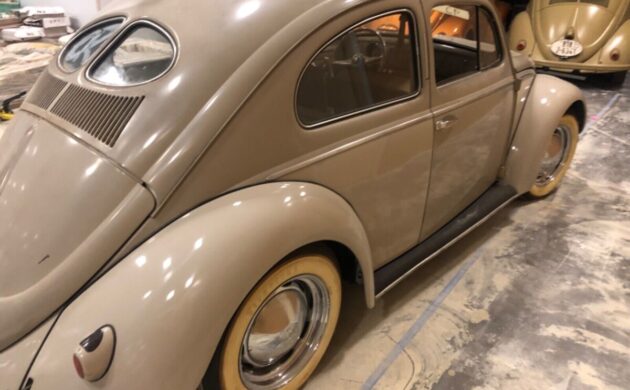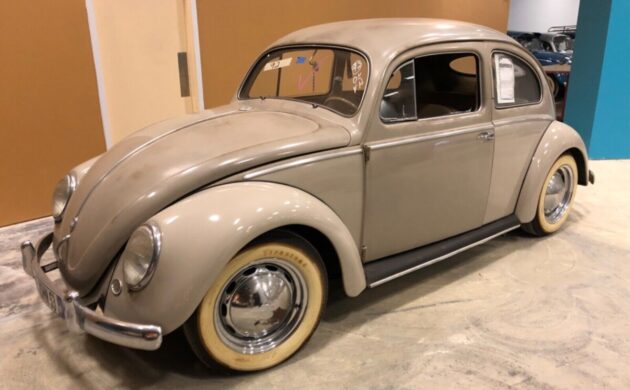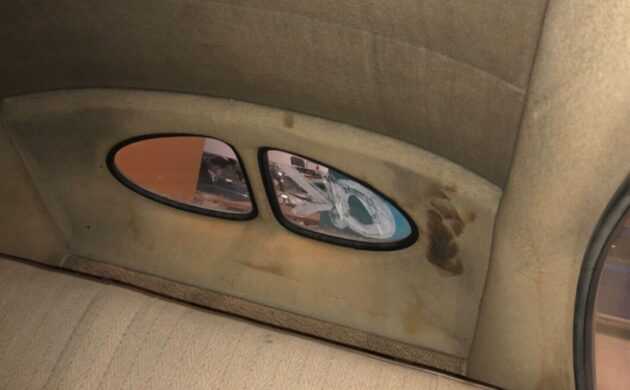The VW Type 1 (aka Beetle) was one of the most tenured names in automobile history, with more than 21 million copies assembled from 1939 to 2003. For the first dozen or so years, the Beetle used a split window set-up in the rear. VW shifted to a solid window in 1953, so the 1950-52 Beetles (the only ones imported to the U.S.) are sought after today by collectors. This one has spent much of its life in one museum or another and looks to be a nice example, though it has a few rough edges. Located in Orlando, Florida, this beige Bug is available here on eBay where $30,800 has yet to crack the seller’s reserve.
A brainchild of the German regime of the 1930s, full-scale production of the ”People’s Car” wouldn’t ramp up until after World War II. More than 114,000 copies were built in 1952, the biggest year so far at that time. It’s not known how many were imported to the U.S., but the percentage of the total is likely to be small. Changes from model year to model year would be minimal and the Beetle wouldn’t become a popular sight in North America until the 1960s. Then they seemed to be everywhere.
As the story goes, this ’52 Beetle was “rescued” from a museum in Puerto Rico, which implies its surroundings were less than desirable. Another museum in Orlando now has the vehicle and lots of other Beetles given the photos provided. We’re told the Bug is complete except for the 1,600-cc air-cooled engine, which is likely of a more recent vintage. And the wheels aren’t original either. The odometer reading is just 23,000 miles, which could be legit.
We’re told this Beetle hasn’t been driven for a long period, but the motor does turn over. At least portions of the paint may not be original as the driver’s side door and hood don’t seem to be the same shade as the rest of the auto. And the headliner is rather dirty, too, although the rest looks presentable. The number of previous owners is said to be just one, so if this VW could talk it might have an interesting yarn to spin.






Not a lot of these running around these days. Nice old Bug.
I had a 72 .I pulled the body , chopped it in half and made a sweet 3 wheeler out of it .
No regrets here .🤠👌💃💃
I had a ’55 when I first started college. It was cheap, reliable, and a really unsafe and bad idea at that time … even worse today! … fun to slowly drive around the block and watch neighbors smile at you? … REALLY?!
Belive it or not the Studerbaker Corportion imported these VW Beatles through Canada .
It wouldn’t make sense that a museum in Puerto Rico bought a 1952 Beetle new. There must have been an owner before them. So there’s a first owner, the Puerto Rico museum, and now this Orlando museum. That’s 3 owners, at least.
The listing doesn’t inspire a lot of confidence, and having purchased several old cars on ebay, I’d definitely want to see this one in person.
A private owner can lend a car to a museum.
Any VW person who knows the PR museum connection, would want to take a VERY CLOSE LOOK at the car before buying. The museum owner had “100 % ORIGINAL” Volkswagen WW2 Military Vehicles which were 100% Made Up / Fabricated in the mind.
It’s too cheap, won’t last long.
Very cool. A couple fine points: the very first Beetle was built in ‘38, and was first offered in the U.S. in ‘49. A total of 2 were sold that year!8
Bunky,
While the basic type 1 VW does date back to it’s introduction in 1938, only a few were built, and none sold to the general public. Those pre-WW2 cars were not called Volkswagen, but rather KDF Wagen. The initials stand for Kraft Durch Freude (‘Strength Through Joy’). The literal translation of Volkswagen is “People’s car”, but that title didn’t become official [along with the VW emblem] until 1945 When the British Army began hand assembling them and needed a name.
In 1990, right after the fall of East Germany [the DDR], I was over there and found an original KDF brochure, and nowhere on the brochure is the name Volkswagen. I’m attaching a copy of the brochure’s cover page.
In 1975 I was rutting around in an old salvage yard in Schwetzingen Germany and found a complete, but not running and with badly rusted pans, 1945 or very early ’46 basic VW with cable brakes and no bumpers. I bought it for 500DM [about $150], but then found out it would cost about $1,500 to have it loaded into a shipping container, trucked to the port of Bremerhaven, and then by ship to the port of Baltimore. Never expecting them to be worth what they are today, I stripped it of the rare parts, instruments, radio, emblems, lights, etc, and I’m pretty sure the car got scrapped.
I wonder how many owners cut out the back window bar?
I had a 72 .I pulled the body , chopped it in half and made a sweet 3 wheeler out of it .
No regrets here .🤠👌💃💃
Many years ago, my old business partner and I made a ’52 into a drag racing car with a Porsche motor. Years later, he had kept all the original ’52 parts, then reassembled it back to stock condition and sold it.
Enough that I have a photo of a pile of the split window portion pieces. An “oval” window replacement was being offered . . . don’t know if it was factory or aftermarket. Fast forward . . . . those split window pieces would now be worth a fortune for “reverse engineering.”
Friend had new 57 split window, my new 58 had big rear window.
I don’t think the 57’s were split windows, small oval maybe? I think I also read that the change from split to oval was a mid-year change in ’52 or ’53? I’m not too sure, not a VW guy. This one looks really good and there isn’t too many too be had, fer sure.
You’re right. Friend;\’s was OVAL, not split. Too many years since 58.
You are correct. You are also correct that in ’53, they “merged” the new Oval window version of the body with “old” Split window version. The most identifiable visual for that is you’d see what looks like an Oval, but the dash is the very cool dash from the “Split”. This somewhat unintended version (using up old parts!!!) is referred to as Zwitter. They are highly prized today.
No split windows in 1957. My first car was a 55 with an oval rear window and a canvas sunroof.
If you didn’t live in Germany in the 1950s, you probably never heard of Mox Nix sticks. They were what the GIs dubbed the mechanical turn signals on European cars.
Mox Nix, by the way, comes from the German macht nichts, which means it really doesn’t matter.
IF it was really a 57, it would have been the last year for the Oval window, unless someone went to the trouble to remove the oval window, and replace it with a Split. Back in the day, replacing an oval with a split was not the trend at all.
Jim, you sure it was a 57? My 55 had an oval window.
This car is from the “Volkyland” sale in PR several years ago….
https://www.oldbug.com/volkyland.htm
Scroll down that page and you can find this car, wearing the same PR license plate in the ebay pictures. Lots of other pictures as well, showing the condition and a picture of the Maryland title to the car (calling into question the “one owner claim” (it doesn’t look like a 1952 title to me))
It’s a car dumbkopf
That’s telling der schweinhund. ;)
This looks like a Zwitter – Dash is not correct for the 50-early 52.
There was an aftermarket shop that made a split window replacement for later VW’s. Required some body work, but looked great!
Where’d they get the brownwall tires? 🤣
In what language does ” one of the most tenured names” have meaning?
It is incumbent upon the reader to decide.
Ok, it’s an earlier split window but let’s keep things in perspective folks. It’s the car that beat out the Model T’s record for production numbers. Millions and millions made. Looks to be in well preserved condition but 30k??
Just over 100,000 of this model made. So not many survivors. Most wrecked, parted out, hacked for projects. So it’s actually kinda rare.
Bug’s were also made for three times as many years as the Model T.
I tried to enlarge the photos to see if this car has the directional signals that pop up from the B pillar. What are they called? Seffafores or something like that.
It looks like it has them as there are no lights next to the headlights or on top of the fenders.
I’ve never had a VW but had a cousin who only owned Beetles and microbuses.
Called the Mox Nix Sticks by GIs in Germany
Close, “ macht nicht “.
They are called semephores
The pillar type signals were called semaphores.
What are the black things on top of the tail lights?
One of the interesting little ??? about vintage VWs are all the nicknames assigned to parts. Those things on the taillights you’re asking about are “heart” shaped, hence these are known as Heart Lights. Other names for various things are pickle forks (door handles) Pope’s nose (license light), bullet lights (front turn signals), pea shooter (tube for dizzy wires), snowflake lights (rear taillights) and the list goes on and on and on . . . .
They are called semephores
Thank you everyone who schooled me on the correct spelling and annunciation of the semephores.
Someone answered a question about those black things on top of the taillights as heart-shaped lights. I have never seen those lights on any VW in all my 70 years.
So I’m going to ask again, what are they? And what was their function? Are they after market?
Sorry . . . I’ll try again, regarding the “Heart Lights”. They seem to serve no function other than emitting a wee bit of light out the top. They are a dark red, not black, and they are small . . . I think a nickel is bigger. You’re right, they are an oddity. You may well have never seen them. Split window VWs are a pretty rare sight in the U.S. As Bunky mentioned above, only two were sold in 1949, and the sales were very minimal until about 54-55. In the beginning, VW allowed cars to be sold pretty much by “anyone” (gas stations, generic repair shops, etc. It wasn’t until they started setting standards that dealerships became respectable, and sales increased.) By then, of course, we were into the “oval” cars. 99% of what you see around today, identifiable as an “old VW” is going to be an oval (53 – 57). Likely, you’ll only see “Splits” at a large VW show, and there might be a handful present. Thus, not odd at all that in your XX years, you haven’t seen “Heart Lights”. BTW, I guess I’m XX+8. Finally, one final correction: its semaphore . . . not semephore.
My guess would be that Puerto Rico never registered the car and that’s where the miles were put on the vehicle as back in those days that country was extremely poor and approximately only 2% of the people had anything at all much less a vehicle so there was no need for licensing office . When the car entered the States it could have been registered for the first time then by the museum .
Most of the car may have the original paint, but the doors are L620 Savannah Beige, a colour VW introduced in 1966.
31K is pretty high for a restorable example. That interior is NOT cheap to replace.
Angel Diva–correction to my reply. I was thinking of a different taillight set-up. Sorry, the partial sentence about ” . . .a nickel being bigger than they are” is incorrect. My apologies. If you look at the main photo, you can see their size . . . still quite small by today’s standards, but certainly bigger than a nickel! They appear to be black, but I believe that happened with age. I believe they were red, when new. All else in my reply is OK. Sorry for the confusion.
This VW was the inspiration for the 1963 Corvette Split Window Coupe! No?
Is the CORRECT headliner material still available?
People complain about the view out the back of a ’63 split window vette? – they should drive 1 of these.
I think it’s riDIculous that the turn signal flasher was invented in 1939 & this ’52 beetle has mechanical directional signalling “semaphores” that flip out behind the doors?! – what if it’s zero degrees out? Not only will you freeze in this car, but the semaphores may be frozen in place after a rain/ice storm. lol
How hard is it to wire in a flasher & 1 extra wire for a blinker?!
Oddly, i see on this bug a conventional turn signal stalk coming out of the steering column on the left – does that operate the left & right semaphores?!
I sure don’t see any blinkers up front.
I don’t particularly disagree with you, except that tons of European cars had “trafficators” (welly English for semaphores) and trafficators well into the 60’s. So, VWs were no worse . . . nor better. They aren’t, by my definition, mechanical, but electrically operated . . . as were their counterparts in Europe.
Yes, the headliner material is still available. In fact, a complete kit is available from many sources, and quite reasonably.
Zwitters were made from October 1952 until March of 1953. There is some debate about whether they are 52 or 53 models but most people consider them early 53s until they were replaced by the Oval windows which are considered later 53s. Either way this car would need a lot to bring it up to the kind of condition that would do well at at VW show. The interior is driver quality. Look at the armrest, stained seats and door panels and rough headliner. And I don’t know what’s going with back seat cover but it doesn’t look stock to me. The engine (with one picture that doesn’t even show the whole engine) is much newer. I guess you could call the paint “patina” but unless it’s bad lighting, the driver’s door is not the same shade.
This car looks to be really solid and after you sort everything out from it sitting in a museum for many years it would no doubt make a nice driver.
Just don’t get over excited or let bidding fever get ahold of you and pay to much. Know what you’re buying. Research first.
Ferdinand Porsche did a nice scaled down version of the DeSoto Airflow two door.
Concerning the headliner;
These early cars had a sound deadener material applied to various insides of the body panels. This was made of a jute fiber or burlap material soaked in a dark asphaltic material, then pressed into a flat panel that can be cut to fit. It was sticky when new, and could be quickly stuck in places like the roof panel, with a couple of sections applied to either side of the rear windows. It’s often found inside doors as well.
Problem is, with many decades the material loses it’s ability to stay attached to the inside of the roof, and they fall down against the headliner material. The headliner is a porous woven cotton material and the asphaltic tar bleeds thru the fabric, causing the situation we see in the photos.
In the case of a few older VW type 1 cars we’ve worked on, we removed ALL the old sound insulation panels and replaced them with newer sound insulation products as they are fully hidden from view. It was a great product for the times, but should be replaced with more modern and efficient products.
This asphaltic sound deadening material is not limited to VW cars, I’ve found it in many European and American vehicles from the 1920s well into the 1970s, including Rolls-Royces and Packards.